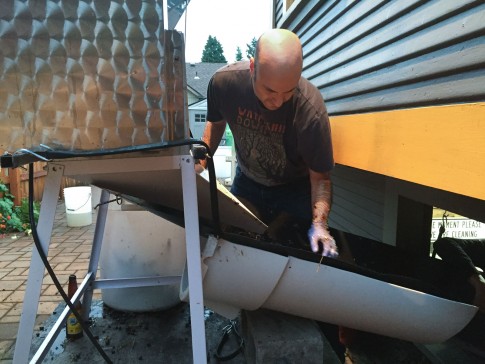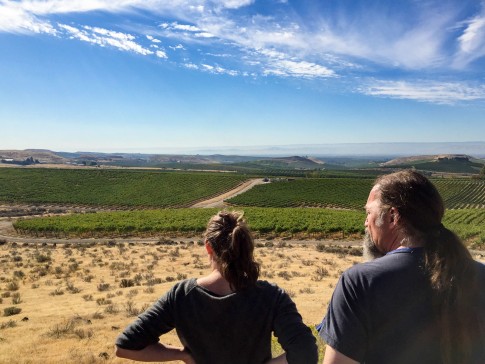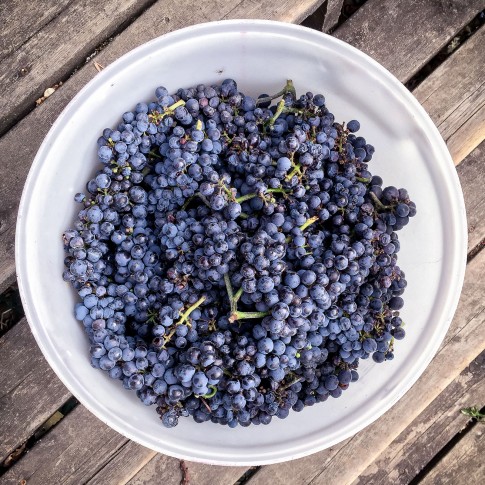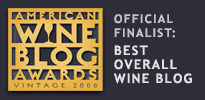Archive for September, 2015
The bittersweetness of the last crush

Jeremy valiantly takes on the messiest job at our last crush of 2015: keeping the destemmer flowing. Luckily, after four harvest evenings spanning 10 varietals (including this pitch-perfect Mourvèdre), we had this crush thing pretty much down, and we were eating and drinking wine by 7:45.
But now, while our 2015 season isn’t over, everything starts to contract: the process moves inside for fermentation, punchdowns and pressings over the next few weeks, so smaller groups are required to coax our grapes toward wine. Ultimately, it’ll end with what Jeremy nudged down the chute last night, as the Mourvèdre eases across the finish line and into the press in an otherwise silent basement a couple of weeks from now.
That’s just how it works, and that’s fine. But as you might guess, for me this moment is bittersweet, marking as it does the end of something, even though there’s still plenty more to come. The early-morning runs out the Gorge into the sunrise, through the cow shit and fertilizer haze of Toppenish and then up out of it into the sun and majestic silence of our vineyards; walking the rows and teasing grapes into my mouth, hoping I’m aware enough to notice the moment when all the tumblers of fruit, acid, depth and balance click and align, unlocking the perfect pick; eight hours of inspiring and all-to-rare one-on-one with whoever goes with me on the trip; and best of all, coming back into the arms of an incredible, diverse and multi-generational group of Garagistes as we all bend our backs and, in a kind of focused chaos, somehow make something beautiful together.
I have to say I kind of live for that. In fact, if making wine didn’t involve it, I’m not sure I’d still be making wine 21 harvests in.
Because the arc of a vintage is like the arc of a life. It begins with a big, wide embrace of people and movement, of everything new, of whatever is now, then slowly quiets and contracts, like Haydn’s Symphony 45, until there’s only one violinist left on the stage.
Except we winemakers — we Garagistes — get to cheat all that. Next September, we’ll point our truck east, out the Gorge, and live that messy, magnificent arc all over again. Already, I can’t wait.
No commentsA long way for a quarter ton. But it’s Mourvedre…


An absolutely beautiful day to pick Mourvèdre.
Analysis: Cabernet, Grenache, and Sangiovese juice and plan
Now that we’ve crushed what we brought in a few days ago, let it sit long enough to even out, and sent samples to the lab for analysis, here’s what I’m thinking about our Cab Sauv, Grenache and Sangiovese.
Cabernet Sauvignon
In short, I think we nailed the pick here: we got the spot-on flavors we wanted without having to go too high in sugar, and at a cost of too much loss of acidity. Left to itself, though, this must would make a 14.8% wine, a bit too high for my taste. So we’ll rehydrate, targeting 14%. Depending on the varietal, I’m generally targeting alcohols between 13.5 and 14%, which seems to be a sweet spot for us. Here, it’s Cabernet — a wine whose nature is bigness — so the target alcohol is on the high side of our range.
That said, once fermentation is over, and the wine’s been racked and aged for 6-8 months (during which time some evaporation will occur), we’ll re-assess the alcohol by how the wine tastes, and make any further water additions as necessary. That’s the same for all of our wines, actually — another reason I shoot a bit high alcohol-size right now – we can always drop alcohol; harder to add it.
Grenache
As we suspected, this critter came in pretty ripe. THat’s in large part because, in the vineyard, the Grenache was really odd this year: it achieved taste-ripeness long before its skins and seeds did. So we had to wait for depth and color, and this is the result. I think it tastes good, but no we really need to open the floodgates on this sucker: left without monkeying, this would be a 17% alcohol wine — if the yeasts could even take it that high before killing themselves in a drunken melee.
So the rehydration here will be pretty huge, targeting 14%. That’s too high for Grenache, but the move is so large here that I want to be conservative; we can always (and probably will) adjust later.
Its pH is also way high, not surprisingly considering the level of sugar (sugar rises as acid goes down as grapes ripen). So that too will be smacked back significantly so we not only have some balance in the wine, it’s protected microbially.
Sangiovese
Pretty lovely numbers as is, as the taste of the juice reflects. The acidity is right where we want it (Sangiovese is always naturally more acidic than the other reds we make). Then I’ll rehydrate just a bit to coax it under 14%.
Sangiovese Rosato
This Rosé is an experiment, but at least in terms of brix and pH, the numbers for Sangio apply here — though what you do with them is different. The acidity you want for a red isn’t the same as for a rose (which is closer to a white wine temperamentally), so I’ll push the acidity back down to 3.45 to start – and I’ll bet we’ll push it lower before we bottle it. Similarly, I’ll push the alcohol lower than for the red; for now, I’ll shoot for 13.6% alcohol.
All in all, the Cab’s going to be excellent, the Grenache its usual relatively uncomplicated but fun self, and the Sangiovese will be awesome, as it always seems to be from this vineyard.
No commentsCrush #2: Three grapes, one haul

Our biggest pick of the harvest – Grenache, Cabernet Sauvignon, and Sangiovese – and a perfect way to spend a birthday.
The (back yard) estate pinot noir
30 pounds of back yard goodness, in one 5-gallon bucket! This is actually the most viable crop I’ve ever gotten from the 21 plants in my back yard – plants I started from cuttings the acclaimed winemaker John Thomas gave me 20 years ago. Usually they succumb to powdery mildew well before harvest comes along. One of many reasons we leave to the pros the viticulture on which our wines depend.
Which isn’t to say this will be an exquisite pinot noir. Oh, no. Just that it will exist and may actually be drinkable. I’ll take it!
No commentsWhat’s next in the vineyard?
My notes from tasting through our vines on Monday. In a nutshell, close, but not quite there yet.
Cabernet Sauvignon: on Monday, most of the Cabernet Sauvignon clusters tasted beautiful. The problem is that a good percentage of them did not. Really odd range of variation. So we’re going to let the Cab hang a bit more to bring those problem clusters closer to loveliness, but not so far that the good stuff goes too far. Maybe early next week?
Sangiovese: some wineries are already picking this, and I can see how you’d make an elegant wine out of it. But I want a little more depth — not too much, by any stretch — so I decided to let those hang as well. Maybe an additional week, too.
Grenache: so very close. As I mentioned earlier, super odd that the juice tastes great but the skins are way behind. But those should be ready to go in a week, too, if not sooner.
Viognier: not there yet; maybe mid next week?
Mourvedre: definitely not there. Maybe 14 days out.
No commentsSyrah and Franc, nice and… ripe
This morning I collected samples of Syrah and Franc and headed out to Newberg, where the wine analysis lab we use has an outpost. And just moments ago, I got the results. The highlights:
Syrah: 25.4 brix, 3.91 pH
Franc: 27.7 brix, 4.07 pH
In a nutshell, this is definitely ripe fruit! Now, Washington fruit always gives us numbers like this — high sugar, low pH — and we’ve rehydrated accordingly, to excellent results. But that said, I have to say these numbers are higher than I’d have thought after tasting them in the vineyard.
But that’s okay. First, the fruit tastes damn good. The flavors are mature and in balance — they taste right — and to me, that takes precedence over the numbers. Not to their exclusion, for sure, but definitely not picking solely by them.
Especially because, second, we can adjust those numbers downstream. And we definitely will: left as they are, the Syrah would be about 15% alcohol, and the Franc 16.5% – way too much alcohol for anyone but teenage boys. So we’ll be adding a few Jesus units (turning water into wine) to bring both down below 14%, and I’ll also be adding acid to bring that pH down into microbially safe territory.
No comments
